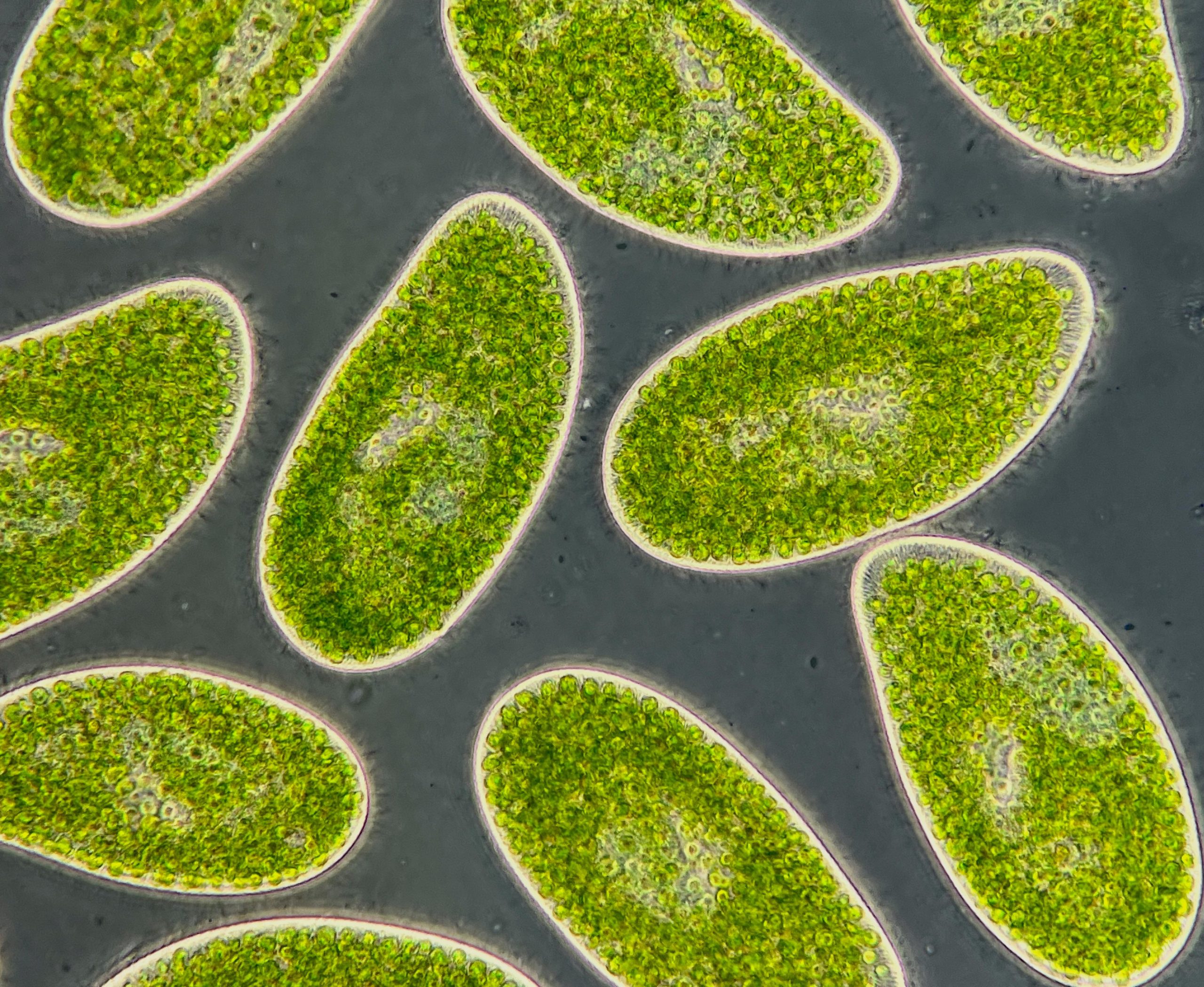
Einzellige Lebewesen wie diese kommen in Seen und Flüssen auf der ganzen Welt vor Paramecium bursaria Es kann sowohl fressen als auch Photosynthese betreiben. Mikroben wie diese spielen beim Klimawandel eine doppelte Rolle, indem sie Kohlendioxid – das wärmespeichernde Treibhausgas, das die Hauptursache für die Erwärmung ist – freisetzen oder absorbieren, je nachdem, ob sie einen tierähnlichen oder pflanzenähnlichen Lebensstil annehmen. Bildnachweis: Daniel J. Wieczynski, Duke University
Zunehmende Hitze könnte ozeanisches Plankton und andere einzellige Organismen in Richtung der Kohlenstoffgrenze drücken, was die globale Erwärmung verstärken könnte. Neuere Studien deuten jedoch darauf hin, dass es möglich sein könnte, Frühwarnzeichen zu erkennen, bevor diese Organismen diesen kritischen Punkt erreichen.
Eine Gruppe von Wissenschaftlern, die eine weit verbreitete, aber oft übersehene Klasse von Mikroben erforscht, hat eine Klima-Rückkopplungsschleife entdeckt, die die globale Erwärmung verstärken könnte. Diese Erkenntnis hat jedoch auch einen Vorteil: Es könnte sich auch um ein Frühwarnsignal handeln.
Mithilfe von Computersimulationen haben Forscher der Duke University und der University of California, Santa Barbara, gezeigt, dass die überwiegende Mehrheit des globalen ozeanischen Planktons sowie viele einzellige Organismen, die in Seen, Torfmooren und anderen Ökosystemen leben, möglicherweise einen Kipppunkt erreichen Punkt. Anstatt Kohlendioxid zu absorbieren, beginnen sie hier, das Gegenteil zu bewirken. Diese Veränderung ist ein Ergebnis der Art und Weise, wie Ihr Stoffwechsel auf die Erwärmung reagiert.
Da Kohlendioxid ein Treibhausgas ist, kann dies wiederum die Temperaturen in die Höhe treiben – eine positive Rückkopplungsschleife, die zu schnellen Veränderungen führen kann, bei denen kleine Erwärmungsmengen große Auswirkungen haben.
Aber wenn wir ihre Häufigkeit sorgfältig überwachen, können wir möglicherweise den Wendepunkt vorhersehen, bevor er eintritt, berichten die Forscher in einer Studie, die am 1. Juni in der Fachzeitschrift Nature veröffentlicht wurde. funktionelle Ökologie.
In der neuen Studie konzentrierten sich die Forscher auf eine Gruppe von Mikroorganismen, die Mixotrophe genannt werden. Sie werden so genannt, weil sie zwei Stoffwechselarten kombinieren: Sie können je nach den Bedingungen Photosynthese betreiben wie eine Pflanze oder auf Nahrungssuche wie ein Tier.
„Sie sind wie[{“ attribute=““>Venus fly traps of the microbial world,” said first author Daniel Wieczynski, a postdoctoral associate at Duke.
During photosynthesis, they soak up carbon dioxide, a heat-trapping greenhouse gas. And when they eat, they release carbon dioxide. These versatile organisms aren’t considered in most models of global warming, yet they play an important role in regulating climate, said senior author Jean P. Gibert of Duke.
Most of the plankton in the ocean — things like diatoms, dinoflagellates — are mixotrophs. They’re also common in lakes, peatlands, in damp soils, and beneath fallen leaves.
“If you were to go to the nearest pond or lake and scoop a cup of water and put it under a microscope, you’d likely find thousands or even millions of mixotrophic microbes swimming around,” Wieczynski said.
“Because mixotrophs can both capture and emit carbon dioxide, they’re like ‘switches’ that could either help reduce climate change or make it worse,” said co-author Holly Moeller, an assistant professor at the University of California, Santa Barbara.
To understand how these impacts might scale up, the researchers developed a mathematical model to predict how mixotrophs might shift between different modes of metabolism as the climate continues to warm.
The researchers ran their models using a 4-degree span of temperatures, from 19 to 23 degrees Celsius (66-73 degrees Fahrenheit). Global temperatures are likely to surge 1.5 degrees Celsius above pre-industrial levels within the next five years, and are on pace to breach 2 to 4 degrees before the end of this century.
The analysis showed that the warmer it gets, the more mixotrophs rely on eating food rather than making their own via photosynthesis. As they do, they shift the balance between carbon in and carbon out.
The models suggest that, eventually, we could see these microbes reach a tipping point — a threshold beyond which they suddenly flip from carbon sink to carbon source, having a net warming effect instead of a cooling one.
This tipping point is hard to undo. Once they cross that threshold, it would take significant cooling — more than one degree Celsius — to restore their cooling effects, the findings suggest.
But it’s not all bad news, the researchers said. Their results also suggest that it may be possible to spot these shifts in advance, if we watch out for changes in mixotroph abundance over time.
“Right before a tipping point, their abundances suddenly start to fluctuate wildly,” Wieczynski said. “If you went out in nature and you saw a sudden change from relatively steady abundances to rapid fluctuations, you would know it’s coming.”
Whether the early warning signal is detectable, however, may depend on another key factor revealed by the study: nutrient pollution.
Discharges from wastewater treatment facilities and runoff from farms and lawns laced with chemical fertilizers and animal waste can send nutrients like nitrate and phosphate into lakes and streams and coastal waters.
When Wieczynski and his colleagues included higher amounts of such nutrients in their models, they found that the range of temperatures over which the telltale fluctuations occur starts to shrink until eventually the signal disappears and the tipping point arrives with no apparent warning.
The predictions of the model still need to be verified with real-world observations, but they “highlight the value of investing in early detection,” Moeller said.
“Tipping points can be short-lived, and thus hard to catch,” Gibert said. “This paper provides us with a search image, something to look out for, and makes those tipping points — as fleeting as they may be — more likely to be found.”
Reference: “Mixotrophic microbes create carbon tipping points under warming” by Daniel J. Wieczynski, Holly V. Moeller and Jean P. Gibert, 31 May 2023, Functional Ecology.
DOI: 10.1111/1365-2435.14350
The study was funded by the Simons Foundation, the National Science Foundation, and the U.S. Department of Energy.








